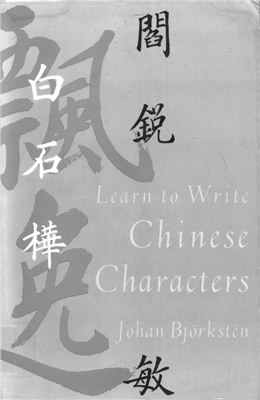Yale University Press, 1994. — 130 p.
Translated from Swedish: Björkstén Johan. Lär dig skriva kinesisks
tecken. Lund: Studentlitteratur, 1992.
Даны начальные сведения о китайском языке и системе
письменности.
Для примерно 400 наиболее распространенных иероглифов и графем приведено написание по чертам с необходимыми указаниями и разбором ошибок и трудностей. Characters are one of the most fascinating aspects of the Chinese language and occupy a prominent place in Chinese culture. Good handwriting is also very important in leaing Chinese: the strokes that make up the characters must be written in a certain rigidly specified order, and they must also be written in a special way.
This book is the only introductory manual for writing Chinese characters prepared specifically for an English-speaking audience. The author guides the reader through the fundamentals of writing and introduces the different types of script used in China today, their evolution, their place in Chinese tradition, and the relations among them. The book provides basic instruction in writing with a mode fountain pen rather than a brush. Only commonly used characters—both simplified and full forms—appear as examples and exercises. Also included is an explanation of how to look up characters in a Chinese dictionary.
This attractive and charming book, full of anecdotes and calligraphic aphorisms, is both a useful classroom tool and an enjoyable reading experience for anyone with an interest in the language and culture of China.
Для примерно 400 наиболее распространенных иероглифов и графем приведено написание по чертам с необходимыми указаниями и разбором ошибок и трудностей. Characters are one of the most fascinating aspects of the Chinese language and occupy a prominent place in Chinese culture. Good handwriting is also very important in leaing Chinese: the strokes that make up the characters must be written in a certain rigidly specified order, and they must also be written in a special way.
This book is the only introductory manual for writing Chinese characters prepared specifically for an English-speaking audience. The author guides the reader through the fundamentals of writing and introduces the different types of script used in China today, their evolution, their place in Chinese tradition, and the relations among them. The book provides basic instruction in writing with a mode fountain pen rather than a brush. Only commonly used characters—both simplified and full forms—appear as examples and exercises. Also included is an explanation of how to look up characters in a Chinese dictionary.
This attractive and charming book, full of anecdotes and calligraphic aphorisms, is both a useful classroom tool and an enjoyable reading experience for anyone with an interest in the language and culture of China.

